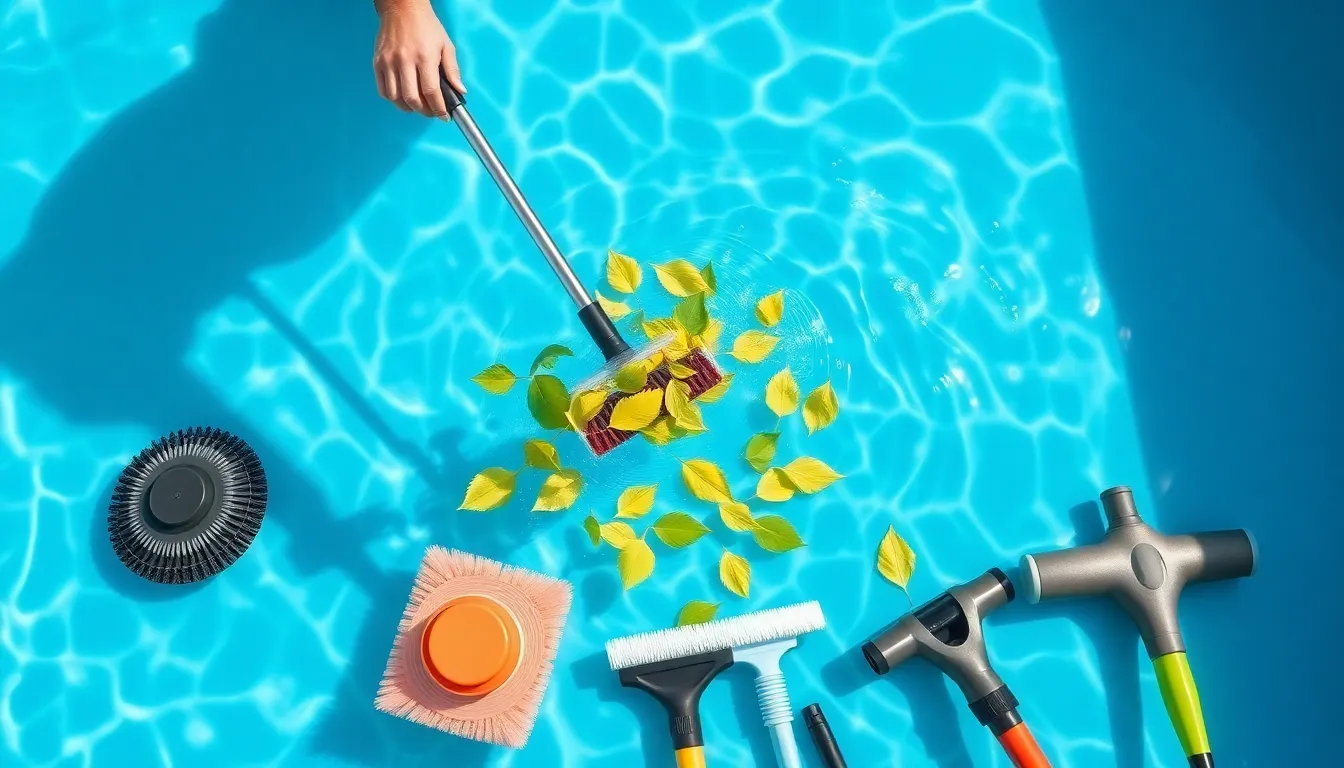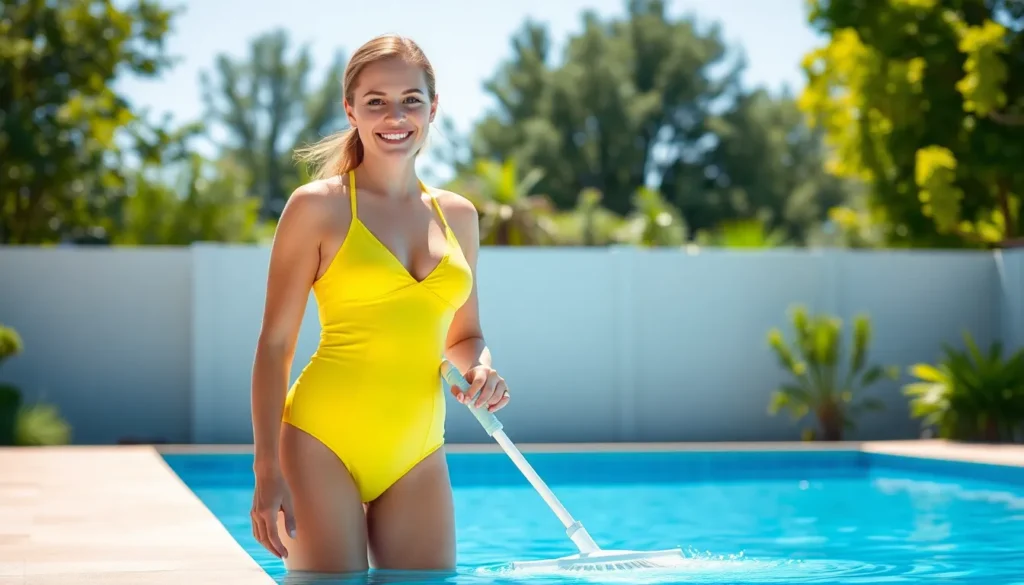Table of Contents
ToggleA sparkling pool isn’t just a backyard luxury; it’s a summer essential. But let’s face it—keeping that oasis clean can feel like a chore. Between leaves, bugs, and the occasional cannonball splash, your pool can turn from a refreshing retreat into a murky swamp faster than you can say “pool party.”
Importance of Pool Cleaning
A clean pool promotes a healthy swimming environment. Maintaining water clarity prevents the growth of harmful bacteria and algae. Regular cleaning reduces the risk of skin irritation and infections.
Health benefits extend beyond enjoyment; clean water offers peace of mind. Clear visibility allows swimmers to see any potential hazards submerged in the pool.
Additionally, consistent cleaning extends the lifespan of pool equipment. When debris accumulates, it can clog filters and strain pumps. Addressing this issue minimizes costly repairs and replacements.
A well-maintained pool enhances aesthetic appeal. An inviting pool encourages more frequent use, contributing to an active lifestyle. Families may spend more quality time together in an appealing environment.
Cost savings become evident when considering energy efficiency. Clean pools require less energy to maintain optimal temperatures and circulation. Efficient operation translates to lower utility bills over time.
Lastly, regular maintenance simplifies preparation for seasonal swimmers. A clean pool eliminates the need for extensive cleaning sessions before gatherings or events. Keeping a routine ensures a ready-to-swim atmosphere anytime.
Tools and Supplies Needed

Cleaning a pool requires specific tools and supplies to ensure efficiency. Gathering the right equipment simplifies the task and leads to a sparkling clean pool.
Basic Tools
Skimmers play an essential role, effectively removing leaves and debris from the pool’s surface. Pool brushes help scrub the walls and floor, tackling dirt and algae. Vacuum heads connect to the pool’s filtration system, removing debris that settles on the bottom. Telescoping poles aid in reaching areas that might seem out of reach. Additionally, a leaf rake offers a more robust option for collecting large debris that skimmers might miss. These basic tools create a comprehensive cleaning routine, allowing for effective maintenance.
Chemical Supplies
Sanitizers maintain water cleanliness and protect against bacteria, ensuring a safe swimming environment. Chlorine tablets serve as a popular choice, providing a reliable source of disinfection. Algaecides prevent and treat algae growth, keeping water clear and aesthetically pleasing. pH balancers adjust acidity levels, contributing to swimmer comfort and equipment longevity. Shock treatments eliminate contaminants quickly, especially after heavy use. By using these chemical supplies, pool owners create a balanced and healthy aquatic environment year-round.
Step-by-Step Cleaning Process
Cleaning a pool involves several essential steps that ensure water clarity and safety. These steps effectively remove contaminants and maintain a balanced aquatic environment.
Skimming and Removing Debris
Skimming the surface removes leaves, insects, and other floating debris. Using a skimmer net attached to a telescoping pole allows easy reach across the pool. It’s beneficial to skim daily, especially during peak seasons. After removing surface debris, larger items, like branches, can be extracted using a leaf rake. Regular skimming prevents debris from sinking, which can complicate the cleaning process later.
Brushing the Walls and Floor
Brushing the pool walls and floor minimizes dirt buildup and prevents algae growth. Utilizing a specific pool brush helps reach corners and ladders effectively. Focus on areas with visible grime as these spots often attract more dirt. It’s advisable to brush weekly to maintain cleanliness. Every brush stroke aids in detaching algae, allowing for better suction during vacuuming.
Vacuuming the Pool
Vacuuming the pool bottom eliminates dirt and debris that skimming misses. Attach a vacuum head to a telescoping pole for thorough cleaning coverage. Manual or automatic vacuums each serve a distinct purpose, depending on preference. Move slowly to ensure maximum dirt removal while avoiding re-suspension of debris. Completing this task weekly promotes longevity for both the pool and its equipment.
Balancing Water Chemistry
Balancing water chemistry ensures a safe swimming environment. Testing kits measure pH, alkalinity, and chlorine levels accurately. Adjusting these levels is crucial for swimmer comfort and equipment preservation. Maintaining a pH level between 7.2 and 7.8 ensures optimal water quality. Regular testing, ideally weekly, facilitates this maintenance, preventing algae growth and ensuring effective sanitation.
Maintenance Tips for a Clean Pool
Regular maintenance keeps a pool clean and inviting. Establish a routine that includes weekly and daily tasks to manage cleanliness effectively. Daily skimming removes debris from the surface, preventing buildup that can lead to contamination. Additionally, continuous monitoring of water chemistry ensures safe swimming conditions.
Brushing the walls and floor once a week prevents dirt accumulation and discourages algae growth. Use a pool brush specifically designed for your pool’s surface to achieve optimal results. Vacuuming should occur weekly, either manually or with an automatic vacuum. This step targets the pool bottom, eliminating hidden debris.
Water chemistry plays a crucial role in maintaining pool hygiene. Test pool water at least once a week to check pH, chlorine levels, and alkalinity. Keeping pH levels between 7.2 and 7.8 enhances swimmer comfort while preventing corrosion or scaling. Chlorine concentrations should range from 1 to 3 ppm to protect against bacteria and other harmful contaminants.
Pool sanitizers, such as chlorine tablets, are essential for ongoing maintenance. Ensure proper dosing according to the manufacturer’s instructions based on pool size and usage frequency. Algaecides also support pool cleanliness by inhibiting algae growth, especially during warmer months.
Lastly, consider seasonal preparations. Before opening or closing the pool, perform a thorough cleaning to minimize algae and debris in cold months. This practice reduces the amount of cleaning required once the pool reopens, making it easier for families to enjoy their summer oasis.
Maintaining a clean pool is vital for enjoyment and safety. By following a regular cleaning routine and using the right tools and chemicals, pool owners can ensure a healthy swimming environment. This proactive approach not only enhances the pool’s appearance but also extends the lifespan of equipment and reduces repair costs. With proper maintenance, families can fully enjoy their summer oasis without the worry of harmful bacteria or algae. A clean pool invites more fun and relaxation, making it a true centerpiece for outdoor gatherings.




